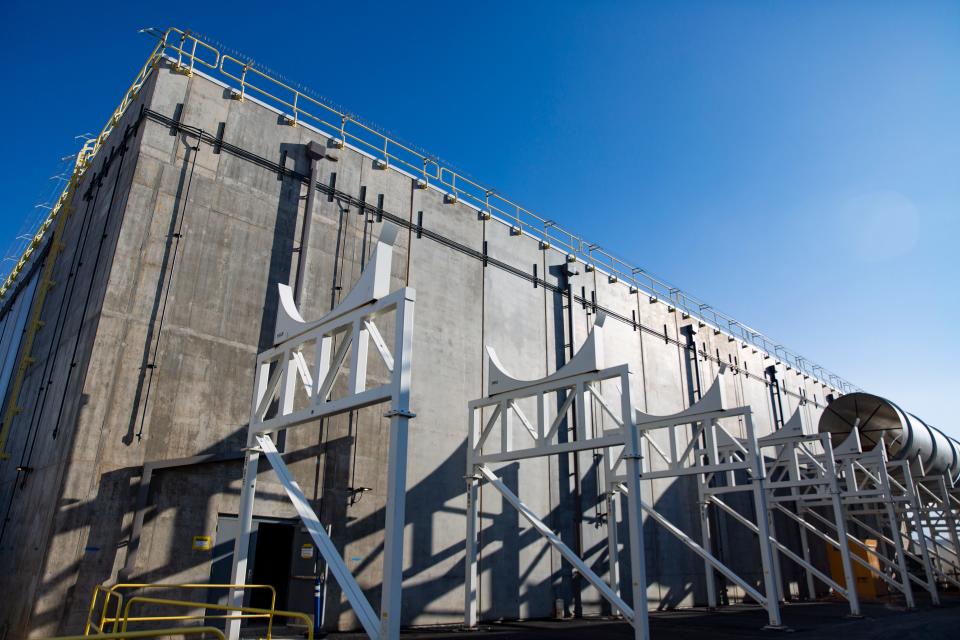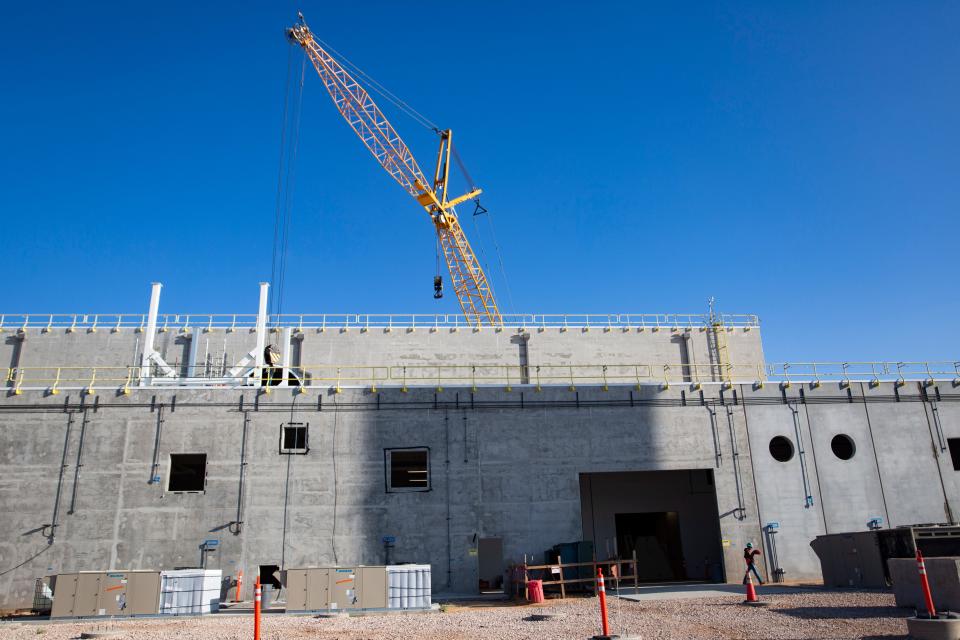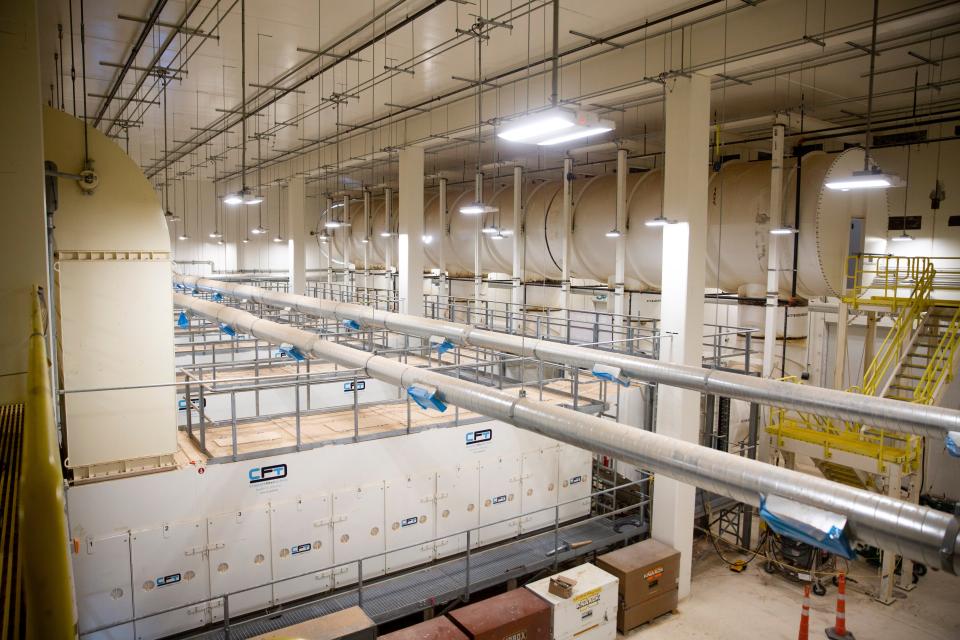Final testing underway at $486M air system for nuclear waste site near Carlsbad
Construction of an almost half-billion-dollar rebuild of the ventilation system at the Waste Isolation Pilot Plant was nearing completion, and testing was being conducted ahead of an expected 2025 start date following years of delays for the project.
It began in 2018, intended to increase airflow in the WIPP underground for workers to breathe, allowing waste emplacement, mining and maintenance to occur simultaneously.
At WIPP, transuranic (TRU) nuclear is disposed of via burial in an underground salt deposit.
More: A nuclear reactor in Carlsbad? City officials call for project at federal waste repository
It is brought via truck to the WIPP site about 30 miles east of Carlsbad from U.S. Department of Energy laboratories and facilities around the country.
Airflow was restricted at the WIPP facility after a ruptured drum from Los Alamos National Laboratory in 2014 contaminated parts of the underground.
The Safety Significant Confinement Ventilation System (SSCVS), combined with a new air intake shaft at the site, was intended to up the remaining air flow from 170,000 cubic feet per minute (cfm) to 540,000 cfm.

More: Oil & gas industry joins fight against nuclear waste site proposed in southeast New Mexico
It was initially planned for completion in 2022 but was marred in delays tied to the COVID-19 pandemic, a dispute with the first contractor hired for the work and a budget climbing from the initial $288 million price tag to the latest estimate at $486 million, according to a 2022 report from the Government Accountability Office.
The DOE announced on Nov. 21 that workers began the commissioning phase of the project, first testing electrical cables for the mechanical aspects of the system like motors, fans and air filtration units.
As work building various components of the SSCVS is completed, they are gradually shifted to commissioning to ensure proper function, read a DOE news release, and interaction with other parts of the system.
More: Feds tout progress in cleaning up nuclear waste at Los Alamos using Carlsbad-area site

The SSCVS will add a layer of protection from any future radiological events in the underground, read the release, by pushing air brought in to the site through a series of fans and filters before it is exhausted into the environment.
That includes two buildings: the Salt Reduction and New Filter buildings.
The Salt Reduction Building will pre-filter salt out of the air as it is drawn from the WIPP underground.
More: Air shaft at nuke repository near Carlsbad hits final depth amid recent safety incidents
Then, the New Filter Building will sees fans push the air through high efficiency particulate air (HEPA) filters, to remove any other contaminates before the air is released above ground.
Michael Gerle, environmental regulatory compliance director with the DOE’s Carlsbad Field Office said the project when complete will support WIPP’s continued mission of cleaning up the DOE’s nuclear waste.
Officials estimated that based on WIPP’s legal capacity and production rates of the waste, the facility could remain operational until 2080, and recently said they planned to increase shipments to the site up to 17 per week.
More: Nuclear waste disposal permit issued for New Mexico site, WIPP to get bigger in November
“The SSCVS will enhance the quantity, and quality, of air flow for our workforce in the WIPP underground mine,” Gerle said. “Additionally, the new infrastructure will ensure our operations remain safe for the environment and the public.”

Switching to the commissioning phase of the project was an important process to ensure the SSCVS would function properly during WIPP operations, said Ralph Musick, capital asset project manager at Salado Isolation Mining Contractors (SIMCO) – the DOE’s primary contractor at WIPP.
“This achievement is the culmination of many people’s efforts to support the engineering, procurement and construction of WIPP’s SSCVS project,” he said. “Initiating commissioning is a careful, step-by-step process to eventually integrate the SSCVS into daily WIPP operations.”
More: New Mexico could try again to challenge nuclear waste storage project in court
Safety issues at both the SSCVS and shaft were reported in the latest Defense Nuclear Facility Safety Board report for October for WIPP, published Nov. 3.
At the shaft, a rigging cable broke after it scrapped against a spool guide, causing a loader vehicle to swing uncontrollably in the shaft, striking a scaffolding platform.
No workers injuries were reported but hoisting and rigging work was suspended amid an indefinite “safety pause,” the report read, until a new hoisting and rigging plan is approved.
Concerns with the SSCVS’s underground continuous air monitors (CAMs) were also expressed, read the report, leading to a “full-scale” emergency exercise which was conducted Oct. 16.
Other CAMs in place at WIPP previously malfunctioned on Sept. 29, read the board’s report for that month, and set off alarms which led to an evacuation of the underground and an order to shelter in place for the rest of the facility.
Adrian Hedden can be reached at 575-628-5516, achedden@currentargus.com or @AdrianHedden on X, formerly known as Twitter.
This article originally appeared on Carlsbad Current-Argus: Final testing underway at new air system for nuclear waste repository

